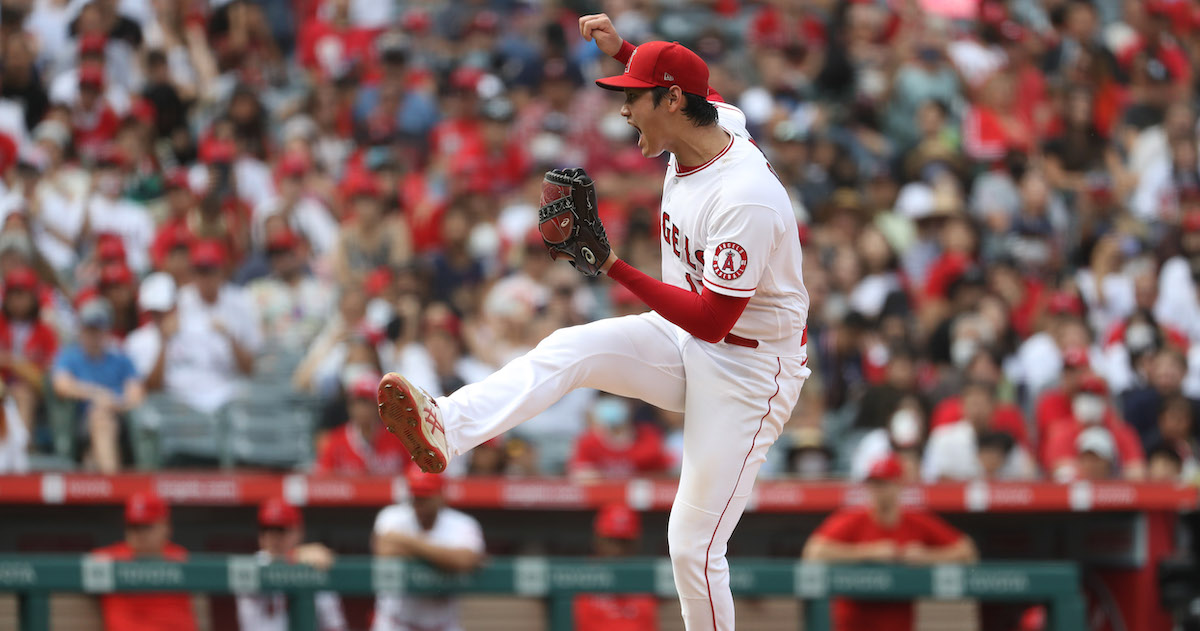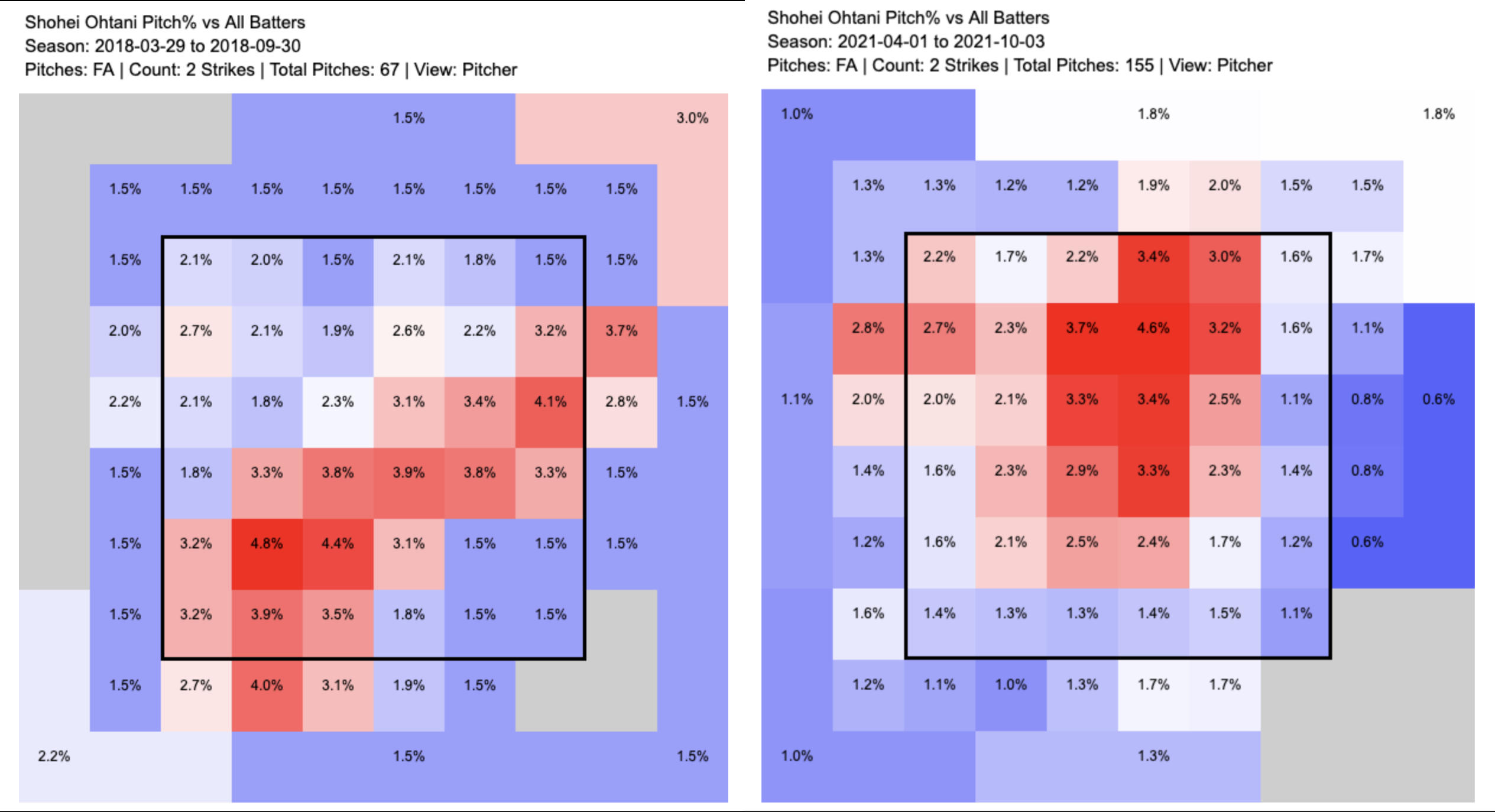Another Way To Appreciate Shohei Ohtani

Picture this: Bases loaded, two outs, full count in a tie game. It’s the ultimate high-stakes situation, and isolated on the mound is the pitcher, left to fend for himself. He can’t mess up — not here, not in front of everyone. He does what only a pitcher can do, and that’s use the adrenaline pent up inside to his benefit. So on the next pitch, he fires off a 100-mph fastball, up and in. The opposing hitter swings… and misses. The crowd goes berserk. Inning over. Jam: escaped.
This is the stuff of legends. It’s a moment we’ve thought about at least once as a kid; there’s nothing quite like a bases-loaded escapade that captures the imagination. The cool thing, though? It’s that major league pitchers have been more than willing to live out this fantasy. In 2018, Sam Miller wrote about which instances produce a pitcher’s fastest fastball, and his conclusions are intuitive: when the pitcher is ahead, especially with two strikes, and when there’s two outs. Our favorite pitchers aren’t just strike-throwing robots; they’re also swayed by the heat of the moment, making them even more entertaining to watch.
Inspired, I started to look at data from last season. With two strikes, pitchers averaged 94.2 mph on their four-seamers. In all other counts, they averaged 93.5 mph, for a difference of 0.7 miles per hour. Not too dramatic, but across a large sample of pitchers, it’s significant nonetheless. It’s here I began to wonder: which pitchers in 2021 had the largest differences between their average four-seam velocity in two-strike counts and non–two-strike counts? Maybe you thought of Max Scherzer, who’s known for having a second, even third gear. He’s up there for sure, but not high enough. Because this is what the top five looks like:
| Player | Pitches | Non-2s Velo | Two-strike Velo | Diff. |
|---|---|---|---|---|
| Shohei Ohtani | 895 | 95.2 | 97.2 | 2.0 |
| Shane McClanahan | 798 | 96.0 | 97.9 | 1.9 |
| Kris Bubic | 1144 | 90.5 | 92.1 | 1.6 |
| Carlos Rodón | 1302 | 94.9 | 96.5 | 1.6 |
| Trevor Bauer | 723 | 93.4 | 95.0 | 1.6 |
Hey there, Shohei.
Shohei Ohtani, as you know, is a walking superlative. As a full-time two-way superstar in 2021, he led the league in both fWAR and rWAR (8.1 and 9.1, respectively). He may have lost the home run lead to Vladimir Guerrero Jr., but he certainly had the most home runs by a pitcher, which on its own is a cause for celebration. Also, he was first in Barrel rate, second in expected slugging percentage, and third in max exit velocity. I would gladly go on, but this article needs to go somewhere. So I admittedly digress.
If you’ll notice, most of these describe Ohtani the hitter. I guess it’s true that, at this point, he’s better at hitting than he is at pitching, but I also think we forget just how good he is at the latter. As a refresher, he throws the filthiest splitter in existence. He also happens to throw a sweeper. I don’t know if that’s intentional, but either way, it happens to be one of the most coveted breaking ball shapes. His secondaries are simply exquisite.
Then there’s the heater. What’s interesting, though, is that it’s arguably Ohtani’s worst pitch. It has a middling amount of raw spin, and not much of it helps to generate vertical movement. Relative to other fastballs with similar velocities, Ohtani’s heater drops considerably as it reaches home plate. Often, that leads to fewer whiffs and louder contact.
But it’s how these deficiencies are being made up for that lets us appreciate Ohtani. Had he stuck to an average velocity of 95–96 mph in every situation, maybe he wouldn’t have put together his pristine numbers from last season. So far, he has relied on four, even five extra ticks to get out of iffy situations. For fun, I’ve prepared a few examples. With one out and men on second and third, here’s a 100.4-mph fastball to strike out Jason Martin:
Next, here’s a 99-mph fastball to Matt Chapman with two outs, bases loaded, and Ohtani’s pitch count at a critical point; if Chapman gets on base, chances are he’s out of the game:
So close! That’s a near-perfect location for a two-strike fastball, but Chapman swings just fast enough to knock it back. Ohtani does end up striking him out with a devastating splitter, so all is well.
Then there’s this beast of a fastball, which popped up early in the season, seemingly out of nowhere:
With two strikes and two outs, that’s a whopping 101 mph — Ohtani’s fastest pitch in 2021. This is, again, just amazing, because of the enormous gap between his maximum fastball velocity (101.1) and his average fastball velocity (95.6). That presents us another question worth answering: Which pitchers in 2021 recorded the greatest margins between their average fastballs and fastest fastballs? With the same 400-pitch minimum as before, here’s who ranks in the top five:
| Player | Pitches | Avg. Velo | Max Velo | Diff. |
|---|---|---|---|---|
| Shohei Ohtani | 895 | 95.6 | 101.1 | 5.5 |
| Kris Bubic | 1144 | 90.9 | 96.4 | 5.5 |
| Michael Pineda | 925 | 90.6 | 95.9 | 5.3 |
| Josh Staumont | 476 | 96.5 | 101.8 | 5.3 |
| Carlos Rodón | 1302 | 95.4 | 100.5 | 5.1 |
Ohtani does it again. No pitcher threw harder in two-strike counts relative to non–two-strike counts. Now, we can say no pitcher recorded a faster pitch relative to his average velocity. There’s a qualifier involved, sure, but the fact that this gap was maintained across a large number of pitches is another exclamation point. Even when Ohtani’s velocity crashed mid-May, he was still able to reach back and touch 98, sometimes 99. Neither he nor Joe Maddon expressed concern over this unexpected decline, and sure enough, he returned to form a few weeks later.
This isn’t a new strategy, however. Back in 2018, Ohtani averaged 96.4 mph on his fastball in non–two-strike counts, and that jumped to 98 mph with two strikes. In Japan, he regularly brought the heat when the occasion called for it. What has changed is how successful he’s been with his approach. When he offered hitters a two-strike fastball in 2018, they still managed to record a .337 wOBA against it. But in 2021, they struggled to the tune of a .151 wOBA. It’s true that Ohtani has become more adept at pitching in the majors, and it’s true that his command has sharpened, but the biggest change is in how he locates his two-strike fastballs. Here’s a side-by-side comparison of both seasons:

Before, with two strikes, Ohtani threw exclusively down in the zone. That does have it benefits — hitters are more likely to take them for called strikes, for example — but at the cost of fewer whiffs. In 2018, opposing hitters swung and missed against 10.6% of those fastballs. Three years later, they swung and missed against 17.9% of them. Ohtani’s fastball shape hasn’t really changed, and he even lost a tick off the fastball, but he did begin to live at the letters. It’s a subtle optimization that’s made him a greater force to reckon with.
But, perhaps because of the energy it requires, he doesn’t throw as many two-strike fastballs as one might expect. As it happens, his two-strike fastball rate of 17.4% is the seventh-lowest among the pitchers we looked at earlier. The majority of his fastballs are thrown in situations when he is either even or behind in the count, and maybe not coincidentally, that’s when hitters have ambushed the heater; they’ve been able to ignore the secondaries and sit on the hard stuff. You could say that Ohtani is, at times, a bit predictable.
Even so, his selective flame-throwing has been more than effective, and unless hitters completely figure him out, there’s no need to alter a years-old approach. Besides, it’s what gives us yet another reason to marvel at Ohtani. You already knew that he’s capable of triple digits. You also know about his tendency to bring out the heat in dire moments. But as usual, it’s nice to have the numbers back up our intuitions. Last season, he was one of the most exciting pitchers in terms of certain fastball velocity differentials. Bases loaded, two outs, full count: In a moment like that, no pitcher was more willing to be a crowd-pleaser than Ohtani. Usually, it worked. It’s part of what makes him so awesome.
Justin is an undergraduate student at Washington University in St. Louis studying statistics and writing.

TIL Carlos Rodon hit 101. Wow.